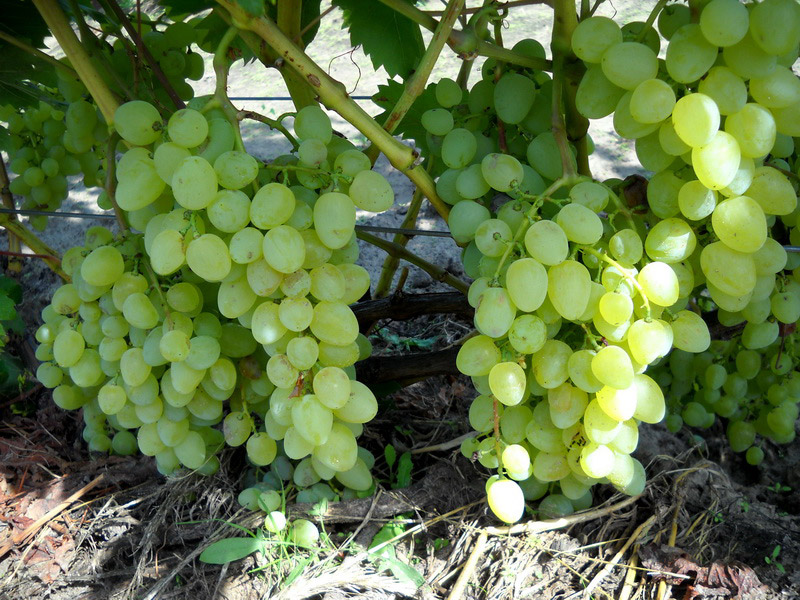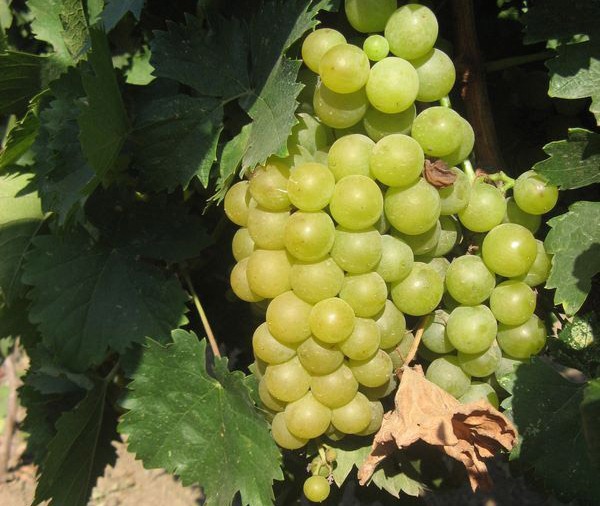Not every grape variety is grown on an industrial scale, although they have decent qualities for this. The Bazhena grape is exactly the variety that has shown itself perfectly both in garden plots and on large-scale plantations.
Description of the Bazhena grape variety
It perfectly combines such qualities as disease resistance, winter hardiness, taste and size of berries, the possibility of transportation and long-term storage of the crop.
The Bazhena grape variety owes its origin to the Ukrainian breeder V.V. Zagorulko. He crossed 2 varieties: Gift to Zaporozhye and Arcadia, as a result of which he received grapes that absorbed the best properties of their parents.
From Arkady, he inherited bisexual flowers, early ripening, resistance to mildew, large berries. From the Sort Gift to Zaporozhye acquired resistance to powdery mildew, high yield.
This white table grape differs from other varieties:
- Early ripening (100-110 days). You can collect it from mid-August.
- Strongly growing bushes.
- Early fruiting, 3 years after planting.
- It does not regenerate and has a bright varietal taste.
- Good resistance to fungal diseases (mildew and mildew).
- Large size of berries and their taste.
Unusual berries, for which the Bazhen grapes are so valued by gardeners, reach a size of 23 mm in diameter, a length of 40-42 mm and a weight of 10-23 g. Fleshy, yellow-amber berries with a thin skin acquire an ovoid elongated shape and are very similar to Arcadia, only 2 times larger. They taste like ripe cherries and contain 18% sugar.
Large (0.7-1.5 kg) grape clusters acquire a classic cone shape or a branchy shape with an average density. They have an unusually attractive appearance. The plant has resistance to mildew and oidium by 3-3.5 points.
The bushes are frost-resistant up to −21-24 ° C, therefore the Bazhena variety is grown both in the southern regions and in the middle lane, including in the Moscow region. For preservation, grapes must be covered for the winter (with sawdust, chakan, improvised material or soil).
Reproduction of grapes Bazhena
Bazhen grapes are propagated by cuttings or by grafting it on another rootstock. Cuttings are harvested during autumn pruning and packed in breathable material to be stored in the refrigerator or other cool place at 4-5 ° C.
In February, they are taken out of storage, inspected and viable cuttings are planted in pots with prepared soil mixture. Then watered and covered with a plastic container, create a greenhouse environment.
When warm weather is established, the seedling is transplanted into open ground, into a hole prepared in the fall.
Dig a hole with a diameter of 80 cm, a depth of 75-80 cm. The bottom is lined with drainage material by 10 cm, then it is covered with a mixture of humus, removed soil and sand, adding a small part (2 kg) of wood ash. In the spring, before planting, mineral fertilizers are applied.
In order for the young seedling to take root well and endure the winter time well, before planting the strongest shoot is shortened to 3 buds, weak shoots are removed. This will allow the bush to use all its strength to form the root system and take root well.
When planting, the roots of the seedling are placed at a depth of 40 cm, after which they are sprinkled with earth mixed with sand, compacted and watered. Young plants like frequent watering.
With the second method of reproduction, vaccination, it is necessary to have skills in this matter and choose the right time.In addition, the variety can improve quality such as winter hardiness. But then the ripening of berries will be postponed to a later date.
Seasonal variety care
When caring for young grapes, it should be borne in mind that he loves regular root watering. He does not tolerate stagnant water, so they make sure that the soil dries out. Watering is carried out:
- when planting seedlings in the ground;
- before and after flowering;
- during the ripening period of berries;
- after harvesting;
- before laying for the winter.
In the first year, young grapes have enough nutrients that were introduced during planting. Top dressing is performed after 2-3 years in spring or autumn. The bushes also respond gratefully to foliar feeding.
In autumn (during the "sleep" period) or early spring (before sap flow), after the opening of the vineyard after winter, pruning is carried out to form powerful shoots. Cut shortly, 3 eyes or 6-8 eyes. Pruning is done annually.
The grapes are distinguished by good fruitfulness, the bushes are vigorous. Almost along the entire length, the shoots ripen well in a season. Powerful clusters are formed on the vines. As a rule, one bunch is formed on one shoot. Experienced growers advise to remove fruits from every fifth shoot, thus rationing the harvest.
Since the Bazhena variety has bisexual flowers and is perfectly pollinated without additional pollinators, there is no reason to worry about fruiting and peeling berries. This can only be prevented by unfavorable weather conditions (frequent rains, sudden frosts or other cataclysms).
Like other varieties, and many plants, the Bazhena variety loves a lot of sunlight. For him, only those places are suitable in which the sun is not blocked by anything throughout the day. A place on the south side of the country house is well suited for planting, which in turn can protect the bush from the winds.
We must try to choose a place for this variety on a hill.
When planting several grape bushes in a row, given the strong growth of the variety, a distance of 5 meters is left between them. This will provide each bush with adequate root nutrition and adequate space for vines to grow. When planting several rows of grapes, provide a gap between rows of 6 meters.
One of the positive characteristics of the variety - resistance to fungi - allows you not to use chemicals for its processing. It is only necessary to spray the bushes with Bordeaux liquid and iron vitriol for the purpose of prevention in spring and autumn. This process is carried out in the early morning or evening hours in calm weather. Solutions are prepared strictly according to the instructions.
If traces of fungus appear on the bushes, you should immediately treat the grapes with stronger preparations. The best effect can be achieved if you do not drag out the time and get rid of the fungus until it has destroyed all the bushes.
The most dangerous pest of the variety is phylloxera (an insect, 1 mm in size, affecting the roots of a plant), brought to Europe from America. It can cause significant damage to viticulture when growing Bazhena and other varieties of grapes that are not resistant to it.
Insecticides are used against phylloxera (carbon disulfide emulsion and others). The safest and most reliable way to prevent its spread is to graft the grapes onto a phylloxera-resistant stock of American origin.
It is important to note that the sandy soil prevents the phylloxera from spreading! In this case, the grapes are fertilized more often.
Those who have already had the opportunity to grow these grapes and enjoy the fruits of their labor speak only positively about them.
Many growers recommend gardeners to plant the Bazhena variety on their plots. It has an extraordinary taste and large, attractive berries.














